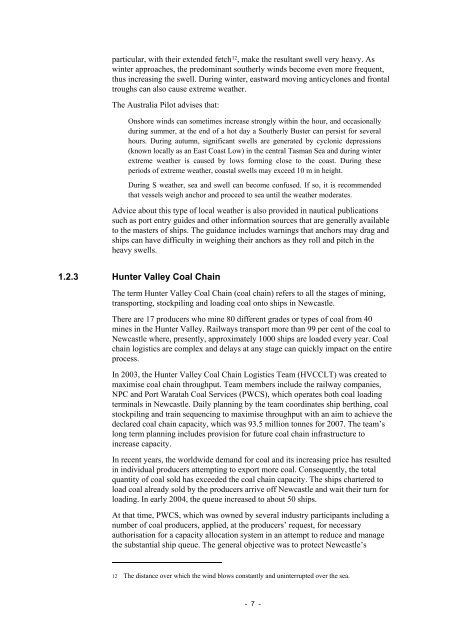Pasha Bulker 243 - Independent investigation into the grounding of ...
Pasha Bulker 243 - Independent investigation into the grounding of ...
Pasha Bulker 243 - Independent investigation into the grounding of ...
Create successful ePaper yourself
Turn your PDF publications into a flip-book with our unique Google optimized e-Paper software.
particular, with <strong>the</strong>ir extended fetch 12 , make <strong>the</strong> resultant swell very heavy. As<br />
winter approaches, <strong>the</strong> predominant sou<strong>the</strong>rly winds become even more frequent,<br />
thus increasing <strong>the</strong> swell. During winter, eastward moving anticyclones and frontal<br />
troughs can also cause extreme wea<strong>the</strong>r.<br />
The Australia Pilot advises that:<br />
Onshore winds can sometimes increase strongly within <strong>the</strong> hour, and occasionally<br />
during summer, at <strong>the</strong> end <strong>of</strong> a hot day a Sou<strong>the</strong>rly Buster can persist for several<br />
hours. During autumn, significant swells are generated by cyclonic depressions<br />
(known locally as an East Coast Low) in <strong>the</strong> central Tasman Sea and during winter<br />
extreme wea<strong>the</strong>r is caused by lows forming close to <strong>the</strong> coast. During <strong>the</strong>se<br />
periods <strong>of</strong> extreme wea<strong>the</strong>r, coastal swells may exceed 10 m in height.<br />
During S wea<strong>the</strong>r, sea and swell can become confused. If so, it is recommended<br />
that vessels weigh anchor and proceed to sea until <strong>the</strong> wea<strong>the</strong>r moderates.<br />
Advice about this type <strong>of</strong> local wea<strong>the</strong>r is also provided in nautical publications<br />
such as port entry guides and o<strong>the</strong>r information sources that are generally available<br />
to <strong>the</strong> masters <strong>of</strong> ships. The guidance includes warnings that anchors may drag and<br />
ships can have difficulty in weighing <strong>the</strong>ir anchors as <strong>the</strong>y roll and pitch in <strong>the</strong><br />
heavy swells.<br />
1.2.3 Hunter Valley Coal Chain<br />
The term Hunter Valley Coal Chain (coal chain) refers to all <strong>the</strong> stages <strong>of</strong> mining,<br />
transporting, stockpiling and loading coal onto ships in Newcastle.<br />
There are 17 producers who mine 80 different grades or types <strong>of</strong> coal from 40<br />
mines in <strong>the</strong> Hunter Valley. Railways transport more than 99 per cent <strong>of</strong> <strong>the</strong> coal to<br />
Newcastle where, presently, approximately 1000 ships are loaded every year. Coal<br />
chain logistics are complex and delays at any stage can quickly impact on <strong>the</strong> entire<br />
process.<br />
In 2003, <strong>the</strong> Hunter Valley Coal Chain Logistics Team (HVCCLT) was created to<br />
maximise coal chain throughput. Team members include <strong>the</strong> railway companies,<br />
NPC and Port Waratah Coal Services (PWCS), which operates both coal loading<br />
terminals in Newcastle. Daily planning by <strong>the</strong> team coordinates ship berthing, coal<br />
stockpiling and train sequencing to maximise throughput with an aim to achieve <strong>the</strong><br />
declared coal chain capacity, which was 93.5 million tonnes for 2007. The team’s<br />
long term planning includes provision for future coal chain infrastructure to<br />
increase capacity.<br />
In recent years, <strong>the</strong> worldwide demand for coal and its increasing price has resulted<br />
in individual producers attempting to export more coal. Consequently, <strong>the</strong> total<br />
quantity <strong>of</strong> coal sold has exceeded <strong>the</strong> coal chain capacity. The ships chartered to<br />
load coal already sold by <strong>the</strong> producers arrive <strong>of</strong>f Newcastle and wait <strong>the</strong>ir turn for<br />
loading. In early 2004, <strong>the</strong> queue increased to about 50 ships.<br />
At that time, PWCS, which was owned by several industry participants including a<br />
number <strong>of</strong> coal producers, applied, at <strong>the</strong> producers’ request, for necessary<br />
authorisation for a capacity allocation system in an attempt to reduce and manage<br />
<strong>the</strong> substantial ship queue. The general objective was to protect Newcastle’s<br />
12 The distance over which <strong>the</strong> wind blows constantly and uninterrupted over <strong>the</strong> sea.<br />
- 7 -
















